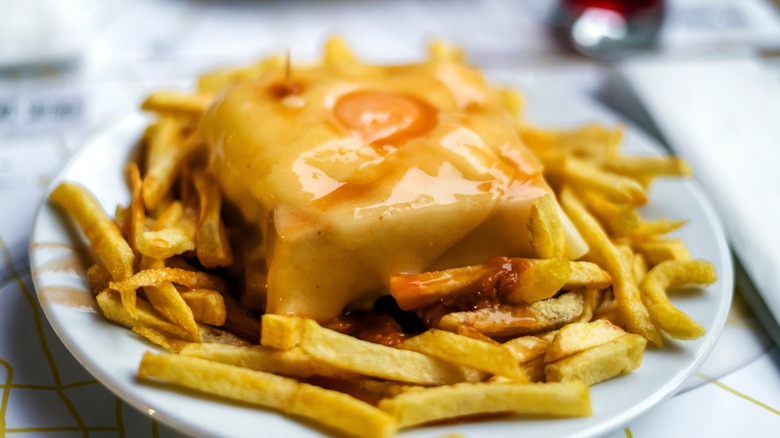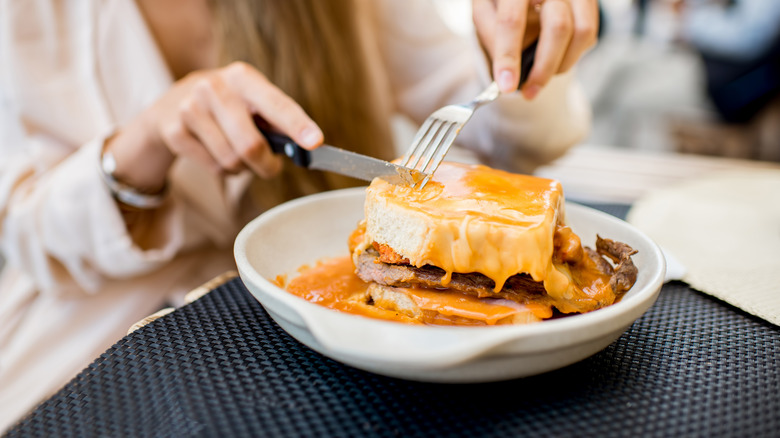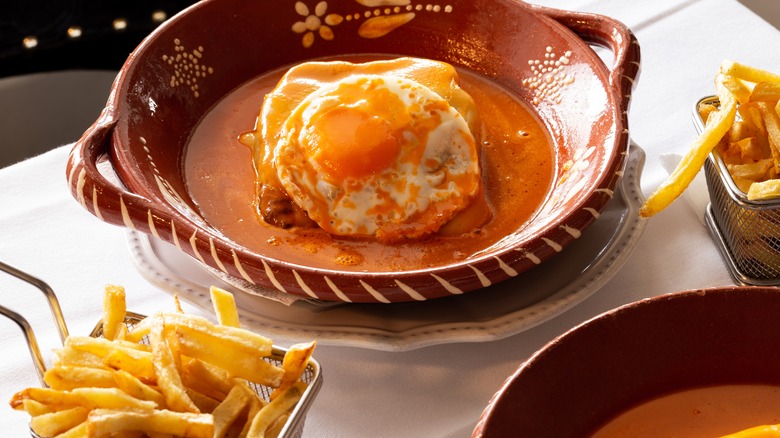Francesinha: Portugal's Overstuffed Sandwich
From a comforting grilled cheese to an herb-filled banh mi, there's a sandwich for every craving. And if the appetite happens to be meat, then look no further than the Portuguese francesinha. Loaded with different sausages, Portuguese ham, and a steak, it's fair to this one's a meat lover's dream. To top off the carnivorous delight, this sandwich is covered in cheese, a spicy tomato beer sauce, and there's even a fried egg on top.
This filling creation may almost sound like too much, but in the hands of a good chef, the components come together. Intertwined with the city of Porto, don't miss sampling the iconic dish in this beautiful town, perhaps after a Port wine tasting or a couple of beers. The francesinha will be sure to leave an impression — and maybe will even inspire a new homespun rendition. Let's dive into how this overstuffed sandwich came about.
History of the francesinha
The exact origins of the sandwich are uncertain, but explanations typically allude to a French influence. Many accredit Portuguese chef Daniel Silva as the originator of the delicious creation. The story goes the cook spent time in France, where he decided to concoct a rendition of the croque monsieur with Portuguese influences. While the sandwich was not the same cornucopia of meat products as today's version, it did include beef in addition to the ham utilized in the French inspiration. The chef returned to Porto and started serving the new dish in 1953 at the restaurant Regaleira, which continues to operate to this day.
What started as a special for regulars quickly spread to other restaurants in the city. New variations arose, with components like the spicy beer sauce, additional meats, and the egg on top. In an ode to its origins and not-so-modest size, locals comically referred to the creation as "little French girl" — or in Portuguese, francesinha.
How the francesinha is prepared
This meat-lovers sandwich involves a range of fillings, including a tenderized beef steak, slices of ham (called fiambre in Portugal), Portuguese sausage linguiça, and even bacon. Some versions employ all the meats, while others only reach for a selection — it depends on the restaurant.
Cooking starts with creating the spicy beer sauce since it takes the longest amount of time. Lard, olive oil, garlic, and bay leaf are heated until simmering, and then onion is added until it turns translucent. The sauce base comes together with canned tomatoes and beef stock, made extra flavorful with the addition of Port wine, a light beer, Worcestershire sauce, and several dollops of Piri-Piri for heat. Flavors and proportions vary — just like with other aspects of the francesinha, many restaurants offer their unique take on the sauce.
Meanwhile, the meats are prepared in a separate pan, often made extra flavorful by utilizing the sausage fat as a base. In addition, two slices of bread are toasted, and an egg is fried, still retaining a runny yolk. Finally, assembly begins, with a slice of cheese accompanying the other fillers in between the toasts. The egg is placed on top, with the yolk still visible, and the exterior of the francesinha is covered in even more cheese. The sauce, still hot, is poured over the sandwich, melting the cheese and making a delicious creation.
How the francesinha is consumed
With such an abundance of cheese and sauce, don't expect to consume the francesinha on the go — it's a fork-and-knife affair. In fact, the sandwich is a popular meal during outings, whether it's at a restaurant, bar, or cafe. Some believe the sandwich is a hangover cure. However, the francesinha is just as likely to be eaten alongside a beer in the evening as in the morning after too many. To enhance its bar-food likability, the sandwich is often accompanied by fries which are drenched in the spicy tomato sauce on the same plate.
The francesinha is now popular all around Portugal, but Porto is still the stronghold with the most well-known restaurants. From haunts serving the same sandwich for decades to modern reinterpretations, there's a rendition to be discovered for every taste. And for those who aren't carnivores, no fear — some restaurants specialize in meat-less spin-offs, too. There's the prawn-topped francesinha à barcarola, meatless francesinha de atum with tuna, and more-recent vegan interpretations filled with tofu.



